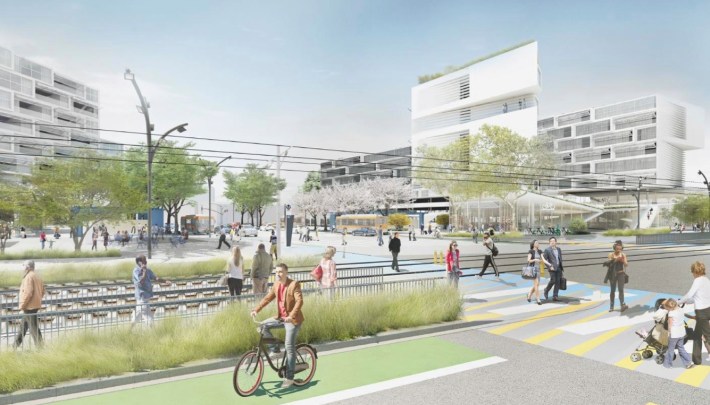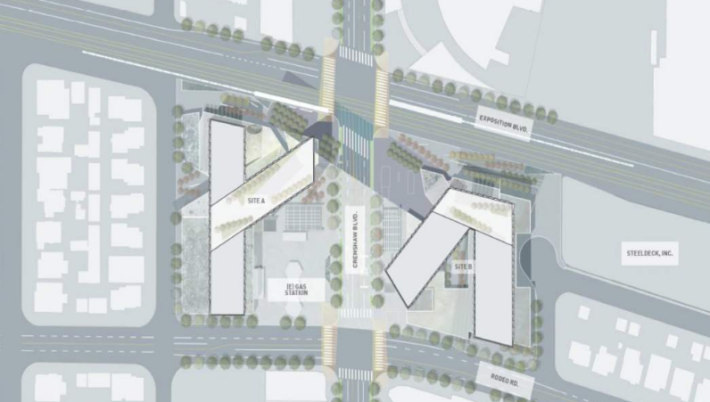Who will drive the outreach?
The question came from Metro Boardmember Jacquelyn Dupont-Walker during Thursday's Executive Management Committee meeting on the subject of the proposal for a housing and retail project on two lots at the convergence of the Expo and under-construction Crenshaw/LAX Lines in South L.A.
The six-month Exclusive Negotiation Agreement (ENA) between Metro, the County, and developer WIP-A, LLC, (a subsidiary of Watt Companies) was ultimately approved by Metro board members Sheila Kuehl, James Butts, John Fasana, and Dupont-Walker (Mayor Eric Garcetti abstained, having received campaign contributions from representatives of Watt Companies). But the question of how the intensive community engagement and partnership building process would unfold over that interim period was raised by board members and public commenters alike.
There had been several meetings with stakeholders about the site between 2015 and 2016 as Metro gathered the input that would inform the development guidelines that would be sent out to potential developers along with the Request for Proposals.
The guidelines (found here) capture the essence of what you hear in the community regarding any pending project of significance - that it provide the community with the kinds of amenities it has been desperate for for so long (entertainment venues, sit-down family restaurants, cafés, a grocery store, places to gather) while also offering a range of housing options (but especially affordable housing) that would help guard against further displacement of the black community.
That may not sound like a unique request, but it is a request that tends to be unique to disenfranchised communities of color. Because of discriminatory housing practices that denied black families the mobility and housing opportunities granted to whites, Los Angeles' wealthiest black residents reside in relatively close proximity to some of its poorest. Meaning that new development must find a way to balance meeting the needs of its well-heeled residents who have long clamored for retailers and investors to respect their dollars while also serving (and avoiding doing harm to) the lower-income residents who are struggling to retain a foothold in the area.
It's a point that is reiterated throughout the guidelines, including under the General Stakeholder Vision, which reminds prospective developers that "housing accessible for people who have lived in the community for their entire lives was seen as a critical place-keeping development strategy."
Notably, however, the guidelines also take special care to make clear that the project would mark a gateway to the historic Crenshaw Corridor. Because residents had "pointed to the unique multi-cultural history of the surrounding community and stated that these factors should shape and differentiate a project" at that site, the guidelines specified, the project should therefore be a "culturally distinct and iconic gateway destination" that served residents while also attracting visitors.
That's not exactly what the community appears to have gotten, judging by the renderings.

Beyond the apparent and troubling rapture of the black population, the proposed project both looks frightfully sterile and appears to underutilize the space available. It gives no indication of where it is, of the fact that it intends to serve the majority black community, of how it will ground itself in the history of the community, or of how it plans to integrate itself into the community's cultural fabric.
And it came up rather short with regard to affordable housing, as well, a point several commenters, including Damien Goodmon of the Crenshaw Subway Coalition (via letter), raised. The developer, WIP-A, LLC, a subsidiary of Watt Companies, would only be offering 15 percent of its 492 units as affordable (approximately 73) to those earning 50 percent or less of the area median income (AMI).
The shortfall is troubling for a few reasons. For one, Metro itself notes the median income in the area is approximately $36,347, meaning that the affordable units might still be out of reach for far too many in the area (the minimum income required to qualify for a unit at 50 percent AMI would likely be somewhere around $30,000 for a family of four). But for another, Metro's own joint development guidelines aim to see a total of 35 percent affordable housing at its transit hub sites. That figure is an overall percentage across the entire portfolio of joint development units, not a specific site requirement. But the fact that affordable housing was one of the top concerns of respondents surveyed in the community and market-rate housing scored comparatively low, and that the three other proposals competing for the site all offered more affordable housing, it is all the more puzzling that this criteria was not given more weight. Or at least more pushback from Metro.

During the discussion of the proposal, Jennifer McElyea of Watt Companies announced that they had been in negotiation with West Angeles Community Development Corporation (CDC) about bringing them on as a community-based partner.
It was important to make sure the project was a reflection of the community, said McElyea, and that the community benefited from it.
It was not immediately clear, however, what the inclusion of the West Angeles CDC would mean for the direction the project would take. They had been the leader of the Crenshaw Corridor Ventures LP team that had also submitted a proposal for the site. In their new role, they would likely have much less power to direct how the project would proceed in a community they are deeply rooted in. Still, it seems like a step in the right direction for Watt, given the CDC's ties in the area and the fact that it already manages affordable housing along Crenshaw and plans to build another senior housing project at 54th.
This news was of little consolation to stakeholders who did not want to see the site go to a firm that was responsible for two major "eyesores" (as one speaker described the settings of Watt's two Ralphs grocery stores) and that they believed would not be responsive to community concerns.
Other commenters expressed their disappointment that the NCNVision proposal was not chosen. They noted that the Capri Investment Group - one of NCNVision's team members - is the black-owned firm overseeing the ongoing renovation and expansion of the Baldwin Hills Crenshaw Plaza and that their proposal would offer 245 of the projected 500 units at levels of affordability between 60 and 80 percent AMI.
If Watt Companies wasn't willing to provide more than the minimum of affordable housing, asked resident Philip Brown, how could they be trusted to commit to local hire?
NCNVision team members also spoke up to express disappointment that the formal protest they had lodged had been rejected. Their project offered 40,000 square feet of space for community uses - more than three times what the Watt proposal offered, argued one. Metro's error in scoring the percentage of equity investment the team would be relying on to finance the project had disadvantaged them, said another.
The committee, for its part, seemed unmoved.
Metro was cognizant that gentrification was a concern, said Nick Saponara, a representative of Metro's Joint Development program.
Watt had had the highest scoring proposal, he said, but it was comparatively weak with regard to the incorporation of community based organizations - something Metro emphasized as part of its Transit-Oriented Communities approach to development.
Still, he continued, Watt's track record in the community meant that it had the capacity to assemble a capable team and deliver a project.
The fact that the proposed project would not be reliant on grants or tax credits to fund its affordable housing made it attractive, given the uncertain environment, said another Metro representative. But if one of the findings from community engagement was that more affordable housing was needed, there would be an effort to seek alternative funding to make that possible.
Which brings us back to Dupont-Walker's question of who would drive the outreach.
There is always someone who is not reached, she said. Recalling the words of the Secretary of Labor (under the previous administration) who had expressed hope that Metro would be at the forefront of fixing gentrification, she suggested they were obligated to continue to try.
This will be a signature project, she continued, saying it was therefore extremely important that legacy businesses from the area be able to move into the site or have a role to play in its construction. Watt Companies may have been one of the few firms willing to invest in the community when others were eager to abandon it, she said, but that did not exempt it from having to work with local businesses or do more intensive community engagement.
Because it did not seem to her that the community was fully alerted to the specifics of the proposal, she concluded, it was important to Metro's credibility to ensure that they were. Residents needed to know that Metro was not going to be party to an intentional effort to change the demographics of the area.
CEO Washington agreed, stating that Metro would both draw on its own databases and work hand in hand with the developer and the West Angeles CDC to ensure that maximum number of stakeholders would be reached. That responsibility would not, he said, be left to the developer.
As noted, the interim ENA was approved Thursday. It will next go before the Metro Board on November 30 and the Board of County Supervisors for approval, after which intensive community engagement around the proposal would begin (likely in the new year). At the end of the six-month period, the revised proposal will be reviewed by Metro and the County. If approved, they would enter into a standard 18-month ENA during which the developer would finalize plans, leases, agreements, and construction documents in preparation for seeking the final approval of the project. For more on the proposal, see our previous story here, project-related documents here, Metro's joint development guidelines for the site (here) and the Crenshaw Corridor (here), and Metro's Crenshaw Line webpage, here.
*This article was updated at 11:05 a.m. on 11/17 to note that it was Jackie Dupont-Walker that voted to approve the proposal, not Phil Washington.







